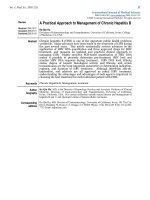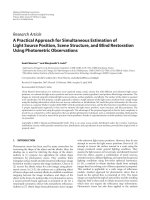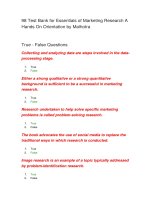Marketing research a practical approach
Bạn đang xem bản rút gọn của tài liệu. Xem và tải ngay bản đầy đủ của tài liệu tại đây (1.93 MB, 313 trang )
Marketing Resear ch
Marketing Resear ch
A Practical Appr oach
Bonita Kolb
© Bonita Kolb 2008
First published 2008
Apart from any fair dealing for the purposes of research or
private study, or criticism or review, as permitted under the
Copyright, Designs and Patents Act, 1988, this publication
may be reproduced, stored or transmitted in any form,
or by any means, only with the prior permission in
writing of the publishers, or in the case of reprographic
reproduction, in accordance with the terms of licences
issued by the Copyright Licensing Agency. Enquiries
concerning reproduction outside those terms should be
sent to the publishers.
SAGE Publications Ltd
1 Oliver’s Yard
55 City Road
London EC1Y 1SP
SAGE Publications Inc.
2455 Teller Road
Thousand Oaks, California 91320
SAGE Publications India Pvt Ltd
B 1/I 1 Mohan Cooperative Industrial Area
Mathura Road
New Delhi 110 044
SAGE Publications Asia-Pacific Pte Ltd
33 Pekin Street #02-01
Far East Square
Singapore 048763
Libr ar y of C ong r ess Con tr ol Num ber : 20 07934524
Br itish Libr ar y C ataloguin g in P ublication d ata
A catalogue record for this book is available from the
British Library
ISBN 978-1-4129-4796-1
ISBN 978-1-4129-4797-8 (pbk)
Typeset by C&M Digitals (P) Ltd, Chennai, India
Printed in Great Britain by TJ International, Padstow, Cornwall
Printed on paper from sustainable resources
Contents
PART I
1
INTRODUCTION TO USES AND METHODS OF
MARKETING RESEARCH
INTRODUCTION TO MARKETING RESEARCH
3
1.1
Resear ch and Marketing Strategy
4
1.1.1
5
Stages of marketing development
1.2 Def ning Marketing Resear ch
7
1.3. The Development of Marketing Resear ch as a Pr ofession
8
1.3.1 Marketing
1.4
1.5
2
1
resear ch today
9
Marketing Resear ch and the Development of the Marketing Plan
10
1.4.1
12
The relationship between data, infor mation and knowledge
Ethics in Marketing Resear ch
13
1.5.1 Ethical resear ch issues
1.5.2 Guidelines for conducting ethical r esear ch
13
14
RESEARCH AS A PROCESS
19
2.1
The Uses of Marketing Resear ch
20
2.1.1 Marketing r esear ch and the or ganization
2.1.2 Resear ch issues
21
21
2.2 The Resear ch Process
2.2.1 Determine the r esear ch question
2.2.2 Sour ces of information
2.2.3 Choose the r esear ch approach
2.2.4 Planning the r esear ch method
2.2.5 Conducting r esear ch and r epor ting f ndings
and recommendations
23
23
23
24
24
25
2.3 Resear ch Approaches
2.3.1 Descriptive resear ch
2.3.2 Explorator y resear ch
2.3.3 Causal resear ch
2.4 Resear ch Methods
2.4.1 Quantitative vs. qualitative r esear ch
2.4.2 Resear ch methodologies
3
29
29
3.1 Critical Thinking
36
3.3
3.4
Marketing Resear ch
28
35
3.2
vi
25
26
27
DETERMINING THE RESEARCH QUESTION
3.1.1
4
25
Critical thinking and faulty assumptions
37
The Critical Thinking Pr ocess
38
3.2.1 Challenging assumptions
3.2.2 Using inter nal data to challenge assumptions
3.2.3 Generating new ideas
3.2.4 Making a cor rect assumption
38
39
40
40
Obtaining Inter nal Secondar y Data to Help in Critical Thinking
42
3.3.1 Obtaining existing inter nal data fr om people
3.3.2 Conducting internal inter views
3.3.3 Deciding not to conduct additional r esear ch
43
44
44
Determining the Resear ch Question
45
3.4.1 Decision-making process
3.4.2 Purpose of the r esear ch question
3.4.3 Resear ch questions and r esear ch approaches
3.4.4 W riting the question
45
46
46
47
THE RESEARCH PROPOSAL
52
4.1 The Resear ch Proposal
53
4.1.1
4.2
Reasons for writing a r esear ch proposal
53
Components of a Resear ch Proposal
54
4.2.1
4.2.2
4.2.3
54
57
Components of a r esear ch proposal – the pr oblem
Components of a r esear ch proposal – the methodology
Components of a r esear ch proposal – analysis
and f ndings
4.2.4 Appendices
59
59
4.3 The Resear ch Industr y
4.3.1 Structure of inter nal marketing r esear ch depar tments
4.3.2 External providers of marketing r esear ch
4.3.3 Guidelines for choosing a r esear ch company
4.3.4 The global r esear ch industr y
4.3.5 Marketing resear ch associations
5
62
63
65
65
65
CULTURAL CONSIDERA TIONS FOR MARKETING RESEARCH
69
5.1
International Marketing Resear ch Challenges
69
5.1.1 Cross-cultural r esear ch at home
5.1.2 Unique resear ch questions
5.1.3 Availability and comparability of secondar y data
5.1.4 Level of cultural dif ference
70
71
71
72
5.2 Language Issues
5.3
5.4
6
61
73
5.2.1 T ranslation needs
5.2.2 Translation during the r esear ch process
5.2.3 Back translation
73
74
75
Hofstede’s Dimensions of Cultur e
75
5.3.1
5.3.2
5.3.3
5.3.4
77
78
79
80
Power distance
Uncer tainty avoidance
Individualism versus collectivism
Masculinity versus femininity
Marketing Ethics and Cultural V alues
80
5.4.1 Ster eotyping
5.4.2 Pr ejudice
81
82
CONDUCTING SECONDAR Y RESEARCH
86
6.1
External Secondar y and Primar y Resear ch Data
86
6.1.1
6.1.2
6.1.3
87
88
88
Institutions that collect secondar y data
Benef ts of conducting secondar y resear ch
Requirements of secondar y data
6.2.1 Secondar y resear ch on the exter nal environment
6.2.2 Secondar y resear ch on the industr y
6.2.3 Secondar y resear ch on the consumer
6.2.4 Or ganizing secondar y data
89
89
90
91
92
Contents
6.2 Secondar y Resear ch Issues
vii
6.3
6.4
Sources of Quantitative and Qualitative Secondar y Data
92
6.3.1 Quantitative secondar y data
6.3.2 Types of qualitative secondar y data
6.3.3 Competitor secondar y data
92
94
96
Steps in the Secondar y Resear ch Process
96
6.4.1
6.4.2
6.4.3
6.4.4
6.4.5
PART II
7
Marketing Resear ch
105
107
7.1
Choosing Par ticipants for Qualitative Resear ch
108
7.1.1 Focus gr oup resear ch par ticipant selection issues
7.1.2 Inter view resear ch par ticipant selection issues
7.1.3 Obser vation resear ch par ticipant selection issues
7.1.4 Pr ofessional recruiters
108
109
109
109
Constr ucting a Sample for Qualitative Resear ch
110
7.2.1 Convenience sampling
7.2.2 Snowballing
7.2.3 Purposive sampling
110
111
112
The Purposive Sampling Pr ocess
113
7.3.1 Identifying characteristics
7.3.2 Identifying or ganizations or gr oups
7.3.3 An invitation to par ticipate
113
113
115
Using Segmentation Characteristics to Develop a Pr of le
115
7.4.1 Choosing par ticipants based on demographics
7.4.2 Psychographic characteristics
7.4.3 Geographic characteristics
7.4.4 Usage characteristics
116
117
120
120
7.3
viii
QUALITATIVE MARKETING RESEARCH
97
98
99
99
100
CHOOSING P ARTICIPANTS FOR QUALIT ATIVE RESEARCH
7.2
7.4
8
Finding data online
Planning the search
Online search strategy
Retrieving online information
Combining the uses of secondar y and primar y data
PLANNING AND CONDUCTING FOCUS GROUPS
124
8.1
Rationale for Using Focus Gr oup Methodology
124
8.1.1
8.1.2
8.1.3
125
126
127
Advantages of using focus gr oups
Disadvantages of conducting focus gr oups
Combining focus gr oup and sur vey resear ch
8.2
8.3
Steps in Developing the Focus Gr oup Methodology
128
8.2.1 Focus Group Preparation
8.2.2 Conducting a focus gr oup
8.2.3 Focus group analysis
128
131
132
Desirable Moderator Characteristics and Skills
133
8.3.1 Desirable personal characteristics
8.3.2 Requir ed skills
133
134
8.4 Handling Group Conf ict
8.4.1
8.4.2
8.5
9
Stages of Gr oup Development
Focus gr oups using nominal gr ouping
135
135
135
Other Venues for Focus Gr oups
137
8.5.1 Videoconfer encing focus groups
8.5.2 Online focus groups
137
137
IN-DEPTH, INTERCEPT AND EXPERT INTER VIEWS
141
9.1
The Rationale for Conducting Inter view Resear ch
141
9.1.1 Inter view stages
9.1.2 Advantages of using inter views
9.1.3 Disadvantages of using inter views
142
142
144
9.2 Types of Inter views
9.2.1 In-depth inter views
9.2.2 Exper t inter views
9.2.3 Inter cept inter views
9.3 W riting Questions
9.3.1
9.3.2
9.3.3
9.3.4
Descriptive questions
Causal questions
Consequence questions
Non-dir ectional questions
9.4 Scr eening Participants
9.5 Constr ucting Questions
9.5.1 General r ules on writing questions
9.5.2 T esting questions
9.5.3 Location of inter views
145
146
147
148
148
148
149
149
149
150
150
151
152
152
153
154
Contents
9.4.1 In-depth inter views
9.4.2 Inter cept inter views
9.4.3 Exper t inter views
145
ix
10 PROJECTIVE, OBSER VATIONAL, ETHNOGRAPHY AND GROUNDED
THEORY TECHNIQUES
10.1 Pr ojective Techniques
10.1.1
10.1.2
10.1.3
10.1.4
Advantages of using pr ojective techniques
Disadvantages of using pr ojective techniques
Types of pr ojective techniques
The process of conducting pr ojective r esear ch
10.2 Obser vational Resear ch
10.2.1 Advantages of obser vational r esear ch
10.2.2 Disadvantages of obser vational r esear ch
10.2.3 Types of obser vations
10.2.4 Designing the obser vational r esear ch process
10.3 Ethnography Resear ch
10.3.1
10.3.2
10.3.3
Advantages and disadvantages of conducting
ethnographic r esear ch
The process of conducting ethnographic r esear ch
Participant involvement in ethnographic r esear ch
10.4 Gr ounded Theor y
10.4.1
10.4.2
PART III
Advantages and disadvantages of conducting
grounded theor y
The process of conducting gr ounded theor y
QUANTITATIVE MARKETING RESEARCH
Marketing Resear ch
11 DETERMINING PROBABILITY SAMPLES
x
11.1 Sampling Issues
11.1.1
11.1.2
11.1.3
11.1.4
11.2
Using a census
Using a sample
Sampling errors
Nonsampling errors
158
159
159
159
159
163
163
164
164
164
166
168
169
169
169
171
171
171
175
177
177
178
178
179
179
Determining the Target Population and the Sample Frame
180
11.2.1 Sampling frame
11.2.2 Probability versus nonpr obability sampling
181
182
11.3 Pr obability Sampling
11.3.1 Simple random sampling
11.3.2 Systematic sampling
183
184
184
11.4
11.3.3 Stratif ed sampling
11.3.4 Cluster sampling
185
186
Determining a Sample Size
187
11.4.1
11.4.2
11.4.3
188
189
Calculating the size of a sample
Normal distribution and variation
Calculating the sample size when estimating
a population pr opor tion
12 QUESTIONNAIRE
DESIGN
12.1 Sur vey Resear ch Methodology
12.2
12.3
194
195
12.1.1 Uses of sur vey resear ch
12.1.2 Questionnair e development needs
195
196
The Questionnair e Design Pr ocess
196
12.2.1 Question topic areas
12.2.2 Writing the draft and management r eview
12.2.3 Coding the question answers
12.2.4 Pretesting the sur vey for m
197
197
198
198
Writing the Question and Answers
199
12.3.1 General guidelines for question writing
12.3.2 W riting the answers
200
202
12.4 Questionnair e Layout
12.4.1 Question
sequence
12.5 Electr onic Sur vey Forms
12.5.1
13 CONDUCTING
13.1
190
205
206
206
Using technology to design new types
of r esponses
208
SUR VEYS
212
213
13.1.1 Resear cher-administer ed sur veys
13.1.2 Self-administer ed sur veys
213
214
13.2 Resear cher-Administer ed Sur vey Methods
214
13.2.1 Personally-administer ed sur veys
13.2.2 Location of personal sur veying
13.2.3 Computer-aided personal sur veys
13.2.4 Resear cher-administer ed telephone sur veys
215
215
216
216
Contents
Methods of Conducting Resear cher-Administer ed Sur veys
xi
13.3
Methods of Conducting Self-Administer ed Sur veys
217
13.3.1 Mail sur veys
13.3.2 W eb-based self-completion
218
218
13.4 Motivating Participation
13.4.1
13.4.2
Providing infor mation to potential par ticipants
The use of incentives
13.5 The Sur vey Process
13.5.1 T raining sur vey takers
13.5.2 Conducting a sur vey
PART IV
222
222
223
227
14 ANALYZING VERBAL AND OTHER QUALIT ATIVE DATA
229
Analysis of Quantitative versus Qualitative Data
230
14.1.1
231
The ar t of qualitative r esear ch
14.2 The Analysis Process
14.2.1 Data organization
14.2.2 The ar t of transcribing r ecordings
14.3 Coding Qualitative Data
14.3.1
14.3.2
14.4
Marketing Resear ch
220
221
ANALYZING AND REPOR TING FINDINGS
14.1
xii
219
Using coding to develop r ecommendations
Software tools for coding
232
234
235
238
238
Analysis of Qualitative Data Content
239
14.4.1 Consumer segments
14.4.2 Consumer behavior processes
14.4.3 Comparing and contrasting consumer traits
14.4.4 Development of hypotheses
14.4.5 Analysis of ethnographic and obser vational
resear ch data
240
240
241
241
15 ANALYZING NUMERICAL DA TA
15.1 Measuring Differences
15.1.1 Scales
15.2
231
of measurement
241
246
247
247
The Process of Quantitative Data Analysis
248
15.2.1
250
Pre-analysis of sur vey data
15.3
Data Analysis using Descriptive Statistics
251
15.3.1 Fr equency
15.3.2 Central tendency
15.3.3 Dispersion measures
252
254
255
Data Analysis using Infer ential Statistics
257
15.4.1
15.4.2
15.4.3
15.4.4
Statistical testing process
Hypothesis
Level of conf dence
Chi-squar e tests
257
257
259
259
16 REPORT WRITING AND PRESENT ATION
262
15.4
16.1
The Impor tance of a W ritten Repor t
263
16.1.1
16.1.2
263
264
16.2
Reasons for pr eparing a r epor t
Types of r esear ch repor t
Components of a W ritten Repor t
266
16.2.1
16.2.2
16.2.3
16.2.4
266
267
268
269
16.3
Intr oduction
Resear ch methodology
Findings and recommendations
Appendices
Writing a Pr ofessional Repor t
269
16.3.1 Using
270
visual material
16.4 An Oral Presentation
16.4.1 Pr esentation structure
16.4.2 Pr esentation rules
16.4.3 Unforgivable sins made during pr esentations
16.4.4 Using visuals during a pr esentation
271
272
274
274
275
Bibliography
280
Index
288
Contents
xiii
PART
1
Introduction to
Uses and Methods
of Marketing
Research
1
Introduction to
Marketing Resear ch
Learning Objectives
1
2
3
4
5
Recognize that r esear ch is an integral component of marketing strategy
Def ne marketing r esear ch
Describe the development of marketing r esear ch as a pr ofession
Explain how marketing r esear ch is incorporated into the marketing plan
Discuss the impor tance of conducting ethical r esear ch
WHAT MOTIVATES Y OUNG PEOPLE TO BUY ? AUTOMAKERS
NEED TO KNOW!
Surprisingly 6 per cent of all US car sales are made to people 16 to 24 years old. Because
this is a sizeable target market segment, automobile companies have spent millions on
design and advertising trying to win this segment’s brand loyalty. However, the distinctive stylish designs created for the Pontiac Aztek, Chrysler PT Cruiser and Toyota Echo
failed to interest young potential auto buyers.
Why did the cars fail to attract buyers? CNW Marketing Research studied young auto
buyers to learn what really motivates them to purchase. They found that the average price
of autos purchased by this group was only $15,000. The research found that young people
were interested in style, but first wanted low price, good value and long warranties.
Was the research correct? The South Korean company Hyundai Motors produced two
cars that offered these benefits. When the automaker introduced the Accent (priced at
$10,000) and the Elantra (priced at $13,000) they were immediately popular with young
people. In fact they were so popular with the target market segment of young consumers
that the overall average age of all buyers was only 24. Hyundai was successful in reaching
the target market of young consumers because not only were the cars relatively inexpensive compared with other vehicles, they also came with long warranties – and they looked
good.
(Continued)
Then other automakers started to consider how they could market to younger consumers. General Motors conducted their research by interviewing minority journalists about
urban and hip-hop culture. As the result of the research General Motors now uses hip-hop
music and musicians in their ads. They also learned that the way to reach young urban
car buyers was to feature Buicks at car accessory and customization shows. Rather than
assuming they know what consumers want, a company is smart to invest in research. In
fact, the money spent on research will actually save money that would otherwise be spent
on wasted efforts.
Question: How do the mistakes that companies make, because they do not conduct
research, cost them money?
Source: Welch, 2004; Chon, 2007
1.1 Research and M arketing S trategy
Marketing is a new field of academic study in comparison to subjects such as chemistry or philosophy. However, marketing is not a new human activity. People have always produced goods
that they wished to barter or sell for either another needed product or money. To do so they
need to find buyers. The field of marketing simply takes this basic human behavior and plans its
strategic implementation.
While there are many definitions of marketing, the definition used by the American Marketing
Association on their website (www.marketingpower.com) describes marketing as:
Marketing Resear ch
Marketing is an organizational function and a set of processes for creating, communicating, and delivering value to customers and for managing customer relationships in ways
that benefit the organization and its stakeholders.
4
The definition describes marketing as an exchange that satisfies both the seller (organization)
and the individual (buyer). Marketing is sometimes misunderstood as only selling, with the organization convincing the buyer to purchase something they don’t want or need. While selling is
an important part of promotion, there would be no long-term gain for any organization to focus
only on selling their product. Even if they could use high pressure sales techniques to convince
buyers to purchase, business success relies on repeat customers. Such customers would most
likely feel manipulated and be unlikely to purchase again. The definition also states that an organization should only provide products that fulfill its goals. Thus the organization has a mission
and a strategic plan and marketing exists to help the organization meet both, while at the same
time meeting the needs of customers.
Therefore, marketing is much more than just the promotion of a product. The field can be
described as a circle with the customer in the middle surrounded by the four ‘Ps’ of promotion,
price, product and place. All four of these components of marketing must provide the customer
with a wanted or needed product at an acceptable price, in an appropriate place, and with
effective promotion. However, to accomplish this goal the organization must first listen to the
customer’s wants and needs.
1.1.1 S tages of marketing development
Marketing has developed and evolved as social and business conditions have changed. An early
approach to marketing was focused only on the production of goods. When consumer goods
became more plentiful, the approach changed to selling as a means of convincing consumers to buy.
Although these two approaches still exist in some industries, the current recommended approach is
the marketing concept that instructs companies to first focus on consumer wants or needs.
Companies using the production concept will emphasize the most efficient way to produce
products that provide high quality and low price. When using this approach companies see
the marketplace of consumers as a single group with similar needs who will purchase any well
made, reasonably priced product. When Isaac Singer invented the home sewing machine there
was a great need for his product. Its successful introduction to the marketplace is an example
of the production approach (see the case study below). The problem with this approach today
is that people can choose from so many products with high quality and low price. Therefore,
consumers also want the products they purchase to provide additional benefits. The production
approach does not address this issue. To determine what additional benefits are desired, it is
necessary to conduct product research.
It is easy to take for granted that in the present day people have the availability to purchase more products then they can possibly need or use. This has not always been true
as there was a time when mass produced goods were uncommon. For example, in the
first half of the nineteenth century all of a family’s clothing had to be handmade. Unless
wealthy enough to employ a seamstress, a woman would arduously produce all her family’s clothes by hand using a needle and thread. This task was in addition to all her other
household chores.
The Singer Company’s introduction in 1858 of the first lightweight home sewing
machine, the ‘Grasshopper’, changed the way clothing was produced. The machine was
inexpensive and allowed women to greatly lighten their workload. For this reason the
machine was immediately popular. Within five years sales had reached 20,000 machines
annually.
Source: Singerco.com, 2007
The sales concept focuses on using the right sales technique. When companies were able to
produce more mass-produced goods than were immediately needed by consumers, they started
Introduction to Marketing Resear ch
THE PRODUCTION CON CEPT AND TH E INVENTION OF TH E
SEWING MACHINE
5
to focus on how to sell products. A company using this approach will assume that customers will
not purchase their product without considerable persuasion. This approach is still used today in
certain industries. For example, life insurance is a product that is needed but that consumers do
not usually enjoy buying. A salesperson needs considerable skill in sales techniques to overcome
this resistance. If the sales concept is used consumer research is still needed to determine which
approach will be most successful. Even with research, the sales concept usually does not lead to
repeat purchases and therefore is generally not recommended for consumer goods.
The marketing concept, which starts by taking into consideration what benefits consumers
desire, is the approach recommended by most marketing experts. This approach is recommended because there are now so many products available in the marketplace that only those
products that provide consumers with the benefits they desire will be purchased.
For example, the Toyota Sienna minivan is one of many minivans on the market targeted at families.
To differentiate their vehicle from the competition’s, Toyota conducted research to find what features
would make traveling with children easier. As a result they included such features as a passenger-side
power sliding door and a rear seat DVD entertainment system. The research succeeded, as Consumer
Reports rates the Sienna as having the most family-friendly features (CR Quick Take, 2004).
The marketing concept, where the needs and desires of the consumer are taken into consideration when the product is designed, is considered the best approach to marketing. However,
in order to follow this concept an organization must know what consumers need and desire.
In fact marketing research is needed equally by both those businesses that sell tangible goods
and those companies that sell intangible services. An example of how a financial institution can
use research is given in the box below. Once again, the only way for companies to know what
consumers desire is through marketing research. For this reason research can no longer be considered an optional activity in which the organization engages if it has the time and money. If
research is not conducted, there is a good possibility that the time and money an organization
does have will be wasted.
Marketing Resear ch
SERVICE BUSINESSES C AN ALSO U SE MARKETING RESEARCH
6
Companies that provide services can also use marketing research to provide information
on consumer wants and needs. Research can provide organizations with information on
the consumer segments to target with their services and also their competitors’ actions.
Credit unions are financial institutions that find new customers by offering membership
to employees of other companies or organizations. The following research questions were
suggested as ways that credit unions could use research to increase membership:
Who are our potential members and where do they work?
What products do they need that they are not getting from their current financial
institution?
What potential companies could we target for membership?
What products are offered by those competing credit unions that are successful in
recruiting new members?
Source: Freeborn, 2004
1.2 Defining Marketing Research
The official definition of marketing research, according to the American Marketing Association,
can be found on the website www.marketingpower.com.
Marketing research is the function which links the consumer, customer, and public to
the marketer through information – information used to identify and define marketing
opportunities and problems; generate, refine and evaluate marketing actions; monitor
marketing performance; and improve our understanding of marketing as a process.
Marketing research specifies the information required to address these issues, designs
the method for collecting information, manages and implements the data collection
process, analyzes the results, and communicates the findings and their implications.
This definition may be meaningful to a marketing professional but may be difficult for someone studying marketing to understand. The definition is easier to comprehend if the four ways
research can be used are explained individually:
1. ‘Identify and define marketing opportunities and problems’ means using research to explore
the external environment.
2. ‘Generate, refine and evaluate marketing actions’ means using research to determine whether
the company is meeting consumer needs.
3. ‘Monitor marketing performance’ means using research to confirm whether the company is
meeting the goals it has set.
4. ‘Understanding marketing as a process’ means using research to learn to market more
effectively.
Introduction to Marketing Resear ch
Although the AMA definition is a useful summary of all that marketing research can accomplish,
a simpler definition can be constructed. According to the dictionary, the word ‘research’ means
to search or investigate exhaustively or in detail. The thesaurus gives as a synonym for ‘research’
the word ‘inquiry’, which means the act of seeking truth, information or knowledge. So market
research can be defined as a detailed search for the truth. Marketing has always had the function of connecting the internal structure of the organization with the external world. Marketing
research is a formalization of this role.
Research that is conducted can be divided into two types. Basic, or pure research, is
conducted to discover new knowledge. When the research is planned and conducted, its
application or how the knowledge might be used is not of major importance. What is important is that new information is discovered. After the research has been conducted, how the
information can be used is then considered. Universities or very large corporations conduct
most basic marketing research.
In applied research, the research is planned so that the findings can be used to solve a specific problem. This is the type of research conducted by marketing professionals working either
within an organization or for an external marketing research provider. After all, if a business is
paying for research to be conducted, it needs results that will show how to solve a problem. Most
businesses do not have the time or money to pay for basic research. The box below provides
additional information on the differences between basic and applied research.
7
BASIC V S. A PPLIED RESEARCH: WHAT’S TH E DIFFERENCE?
An example of a journal that contains basic research is the Journal of Marketing Research.
The American Marketing Association (AMA) which publishes the journal states it ‘is written for those academics and practitioners of marketing research who need to be in the
forefront of the profession and in possession of the industry’s cutting-edge information’.
In the November 2006 issue are such articles as:
‘Optimal Pricing Strategies’
‘Brand Association Maps: A Methodology for Identifying Brand Association
Networks’
‘The Role of Relational Embeddedness in Retail Buyers’ Selection of New Products’
An example of a journal that contains applied research is the Journal of Marketing. Also
published by the AMA, it is ‘to lead in the development, dissemination, and implementation of marketing concepts, practice and information and to prove and promote the use
of marketing concepts by businesses, not-for-profits, and other institutions for the betterment of society’. In the October 2006 issue you can find such articles as:
‘Achieving Marketing Objectives Through Social Sponsorships’
‘Upgrades and New Purchases’
‘Influence Tactics for Effective Adaptive Selling’
Marketing Resear ch
Source: AMA, The Information Source, 2006
8
The important fact to remember about applied research is that the information gathered will be
used to assist in making decisions. The decision might be critical and costly, such as which new
product to introduce. Or the decision might be of lesser importance, such as what color should
be used in a brochure. Whatever the decision, the rationale of all applied marketing research is
to help organizations to limit risk, because making mistakes is expensive.
Decisions that carry a great deal of risk, such as new product introductions, will require a great
deal of research. In fact a full-scale research project combining more than one research method
and a large number of participants may be needed. Conducting the research will be costly but
the expense is acceptable because making the wrong decision will result in a very expensive
mistake. A small decision, such as what color to use in a brochure, still needs marketing research
to eliminate risk – but the research can be on a much smaller scale because the risk, which here
is only the cost of reprinting the brochures, is less.
1.3 The De velopment of Marketing Research as
a Profession
At the beginning of the twentieth century there was a growth both in the number of universities
and also in the number of academic fields being taught. These new academic subjects, including
1.3.1 Marketing research today
Students who have studied marketing research are often employed in the marketing departments
of large companies. Specialized marketing research firms also employ marketing research professionals. These firms contract to provide market research for businesses and nonprofit organizations that do not have the employees to conduct their own. The box below shows two job
advertisements and what qualifications are needed.
Introduction to Marketing Resear ch
psychology and sociology, were interested in applying scientific methods to social problems in
ways that would help to explain human behavior. However, this interest in applying scientific
methods did not apply to purchase behavior and there was, as yet, no academic area of study
called ‘marketing’ or ‘marketing research’.
Yet during the same time span, in the business world marketing research became a recognized
professional field. Throughout this period of economic history businesses were starting to grow
from small local or regional companies to larger national companies. Since they were now selling
their products over a wider geographic area it became more difficult for companies to identify
and understand their customers.
Such an early marketing problem was faced by auto manufactures. Once people who had
the desire and money to purchase cars had done so, the manufacturers needed to know
how to use advertising to reach additional consumers. As a result, the research method of
surveying was borrowed from the social sciences. However, early research survey studies
confronted the key problem of identifying the appropriate consumers to include as participants. So once again researchers turned to scientific methods and adopted sampling to
identify the appropriate consumers to include in studies. This new method was useful
when the potential consumer group was large in number, which was indeed the case for
auto manufacturers. However, the research conducted was limited to focusing on finding
customers for existing products rather than finding out about consumer desire to improve
products.
Market researchers soon discovered that besides surveying and sampling, they could also
borrow additional techniques from the social sciences. In 1931 a manual for marketers,
Marketing Research Technique, described not only how to use surveys but also discussed
interviewing and focus groups as ways of conducting marketing research. Because of the
successful use of these new techniques, interest in marketing research continued to grow
during the 1930s.
After the end of World War II, there was a pent-up demand from people for the consumer
goods they could not purchase during the war years. However, once production caught up with
demand, companies realized their need to learn sales techniques. When such sales techniques
did not sell enough products, they then tried to find additional customers and so started to focus
on meeting consumer desires for products. Marketing research was now needed to determine
these desires and specialized marketing firms developed to provide marketing research services
to companies. As a result, universities started to teach marketing research as an academic field to
provide the necessary professionals.
Academic research continues to play a role in the development of marketing science to solve
management problems. In fact as marketing, including marketing research, is becoming more
common in emerging markets, academic researchers have proposed new models that will help
businesses gain needed information (Burgess and Steenhamp, 2006).
9
I WANT THE JOB !
Below are two job descriptions that give some idea of the range of duties and responsibilities that a market researcher may perform:
Marketing Research Professional within a Corporate Marketing Department
The person will design and execute project plans for market research studies, including customer satisfaction and market awareness, design surveys, analyze results and prepare concise reports that communicate research findings. They must also be able to conduct analyses,
trending, and interpretation of data for use by the sales division. He or she will work closely
with the sales force to communicate critical market research findings. The person hired must
have strong analytical and communications skills, and be skilled in quantitative and qualitative research methods, survey design, statistical analysis, and data collection techniques.
Marketing Research Planner in a Specialized Market Research Firm
Marketing Resear ch
The person hired will assume responsibility for managing all aspects of client research
projects. This will include designing and managing focus groups and surveys, analyzing the
resulting data, presenting results, and making recommendations to the client to help them
make critical decisions. The person will also work in cooperation with other staff members
in marketing research projects to new clients. Thorough knowledge of marketing research
methods is essential along with excellent leadership, analytical, and presentation skills. The
ability to independently manage marketing research projects is a must.
10
Marketing research responsibilities with corporate marketing departments or with specialized
firms include conducting studies using methods that gather statistical information (quantitative
studies). Other professionals conduct studies that gather verbal and other types of data (qualitative). Most marketing research jobs require skills in conducting both types of research.
Job responsibilities within a marketing research firm or department at the lowest level will include
tabulating results and assisting in preparing final reports. Positions with more authority would include
analysts who plan research projects, analyze data and write the reports. Specialized responsibilities
would include people trained to conduct the research, such as focus group moderators and statisticians who can use computers to work with large volumes of data. Above everyone would be
a research director who would report to the client who hired the research firm or, if the research
department is in a large firm, to upper management. However, today all business people should learn
marketing research skills because they are critical to successfully managing a business.
1.4 Marketing Research and the De velopment of
the Marketing Plan
Research is too often thought of as only being useful in answering specific marketing questions. It is true that research is needed to answer such questions as what types of new products









